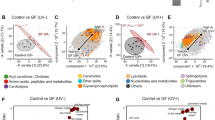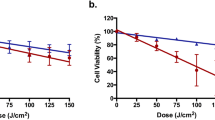Abstract
Many alterations to the skin microbiome by exposure to UV radiation (UVR) have been postulated and may contribute to the ability of UVR phototherapy to regulate skin inflammatory diseases. Very recently, an effect of sub-erythemal narrowband UVB radiation (311 nm) on the gut microbiome of healthy individuals was reported. The relative abundance of Firmicutes and Proteobacteria increased in faecal samples of those receiving three exposures to narrowband UVB radiation; the Bacteroidetes phyla were reduced by UVB. In mice chronically exposed to sub-erythemal broadband UVR, similar faecal changes in Firmicutes and Bacteroidetes have been reported. Murine studies have allowed a further dissection of the relative ability of UVR and dietary vitamin D to modulate the gut microbiome by analysis of relative bacterial abundance in mice with similar 25-hydroxy vitamin D levels obtained by UVR exposure or from their diet, respectively. The studies of mice recovering from colitis suggested that dietary vitamin D could stimulate greater faecal abundance of Rikenellaceae, whilst exposure to UVR was necessary for changes to the abundance of Lachnospiraceae and Desulfovibrionaceae. Both human and murine studies report that multiple exposures to sub-erythemal UVR can increase the diversity of the gut microbiome, which in turn may be beneficial to the health of the host.
Similar content being viewed by others
References
P. H. Hart, R. M. Lucas, D. R. Booth, W. M. Carroll, D. Nolan, J. M. Cole, A. P. Jones and A. G. Kermode, Narrowband UVB phototherapy for clinically isolated syndrome: A trial to deliver the benefits of vitamin D and other UVB-induced molecules Front. Immunol., 2017, 8, 3.
P. H. Hart and M. Norval, Ultraviolet radiation-induced immunosuppression and its relevance for skin carcinogenesis Photochem. Photobiol. Sci., 2018, 17, 1872–1884.
P. H. Hart, M. Norval, S. N. Byrne and L. E. Rhodes, Exposure to ultraviolet radiation in the modulation of human diseases Annu. Rev. Phytopathol., 2019, 14, 55–81.
J. J. Bernard, R. L. Gallo and J. Krutmann, Photoimmunology: how ultraviolet radiation affects the immune system, Nat. Rev. Immunol., 2019, 19, 688–701.
D. Liu, B. O. Fernandez, A. Hamilton, N. N. Lang, J. M. C. Gallagher, D. E. Newby, M. Feelisch and R. B. Weller, UVA irradiation of human skin vasodilates arterial vasculature and lowers blood pressure independently of nitric oxide synthase, J. Invest. Dermatol., 2014, 134, 1839–1846.
S. Geldenhuys, P. H. Hart, R. Endersby, P. Jacoby, M. Feelisch, R. B. Weller, V. Matthews and S. Gorman, Ultraviolet radiation suppresses obesity and symptoms of metabolic syndrome independently of vitamin D in mice fed a high-fat diet, Diabetes, 2014, 63, 3759–3769.
N. Fleury, M. Feelisch, P. H. Hart, R. B. Weller, J. Smoothy, V. B. Matthews and S. Gorman, Sub-erythemal ultraviolet radiation reduces metabolic dysfunction in already overweight mice, J. Endocrinol., 2017, 233, 81–92.
E. S. Bosman, A. Y. Albert, H. Lui, J. P. Dutz and B. A. Vallance, Skin exposure to narrow band ultraviolet (UVB) light modulates the human intestinal microbiome, Front. Microbiol., 2019, 10, 2410.
A. Schwarz, A. Bruhs and T. Schwarz, The short-chain fatty acid sodium butyrate functions as a regulator of the skin immune system, J. Invest. Dermatol., 2017, 137, 855–864.
S. Felton, F. Navid, A. Schwarz, T. Schwarz, R. Glaser and L. E. Rhodes, Ultraviolet radiation-induced upregulation of antimicrobial proteins in health and disease, Photochem. Photobiol. Sci., 2013, 12, 29–36.
V. K. Patra, K. Wagner, V. Arulampalam and P. Wolf, Skin microbiome modulates the effect of ultraviolet radiation on cellular response and immune function, iScience, 2019, 15, 211–222.
M. Tanaka and J. Nakayama, Development of the gut microbiota in infancy and its impact on health in later life, Allergol. Int., 2017, 66, 515–522.
M. Assarsson, A. Duvetorp, O. Dienus, J. Soderman and O. Seifert, Significant changes in the skin microbiome in patients with chronic plaque psoriasis after treatment with narrowband ultraviolet B, Acta Derm.-Venereol., 2018, 98, 428–436.
J. Durack and S. V. Lynch, The gut microbiome: Relationships with disease and opportunities for therapy, J. Exp. Med., 2019, 216, 20–40.
P. I. Costea, F. Hildebrand, M. Arumugam, F. Bäckhed, M. J. Blaser, F. D. Bushman, W. M. de Vos, S. D. Ehrlich, C. M. Fraser, M. Hattori, C. Huttenhower, I. B. Jeffery, D. Knights, J. D. Lewis, R. E. Ley, H. Ochman, P. W. O’Toole, C. Quince, D. A. Relman, F. Shanahan, S. Sunagawa, J. Wang, G. M. Weinstock, G. D. Wu, G. Zeller, L. Zhao, J. Raes, R. Knight and P. Bork, Enterotypes in the landscape of gut microbial community composition, Nat. Microbiol., 2018, 3, 8–16.
A. D. Truax, L. Chen, J. W. Tam, N. Cheng, H. Guo, A. A. Koblansky, W. C. Chou, J. E. Wilson, W. J. Brickey, A. Petrucelli, R. Liu, D. E. Cooper, M. J. Koenigsknecht, V. B. Young, M. G. Netea, R. Stienstra, R. B. Sartor, S. A. Montgomery, R. A. Coleman and J. P. Ting, The inhibitory innate immune sensor NLRP12 maintains a threshold against obesity by regulating gut microbiota homeostasis, Cell Host Microbe, 2018, 24, 364–378.e6.
S. Ghaly, N. O. Kaakoush, F. Lloyd, L. Gordon, C. Forest, I. C. Lawrance and P. H. Hart, Ultraviolet irradiation of skin alters the faecal microbiome independently of vitamin D in mice, Nutrients, 2018, 10(8), 1069.
S. Ghaly, N. O. Kaakoush, F. Lloyd, T. McGonigle, D. Mok, A. Baird, B. Klopcic, L. Gordon, S. Gorman, C. Forest, R. Bouillon, I. C. Lawrance and P. H. Hart, High dose vitamin D supplementation alters faecal microbiome and predisposes mice to more severe colitis, Sci. Rep., 2018, 8, 11511.
P. H. Hart, M. A. Grimbaldeston, G. J. Swift, A. Jaksic, F. P. Noonan and J. J. Finlay-Jones, Dermal mast cells determine susceptibility to ultraviolet B-induced systemic suppression of contact hypersensitivity responses in mice, J. Exp. Med., 1998, 187, 2045–2053.
T. Gaschott, O. Werz, A. Steinmeyer, D. Steinhilber and J. Stein, Butyrate-induced differentiation of Caco-2 cells is mediated by vitamin D receptor, Biochem. Biophys. Res. Commun., 2001, 288, 690–696.
M. L. Santoru, C. Piras, A. Murgia, V. Palmas, T. Camboni, S. Liggi, I. Ibba, M. A. Lai, S. Orru, S. Blois, A. L. Loizedda, J. L. Griffin, P. Usai, P. Caboni, L. Atzori and A. Manzin, Cross sectional evaluation of the gut-microbiome metabolome axis in an Italian cohort of IBD patients, Sci. Rep., 2017, 7, 9523.
S. A. Bora, M. J. Kennett, P. B. Smith, A. D. Patterson and M. T. Cantorna, The gut microbiota regulates endocrine vitamin D metabolism through fibroblast growth factor 23, Front. Immunol., 2018, 9, 408.
M. T. Cantorna, K. McDaniel, S. Bora, J. Chen and J. James, Vitamin D, immune regulation, the microbiota, and inflammatory bowel disease, Exp. Biol. Med., 2014, 239, 1524–1530.
A. T. Soderholm and V. A. Pedicord, Intestinal epithelial cells: at the interface of the microbiota and mucosal immunity, Immunology, 2019, 158, 267–280.
S. Kawamoto, M. Maruya, L. M. Kato, W. Suda, K. Atarashi, Y. Doi, Y. Tsutsui, H. Qin, K. Honda, T. Okada, M. Hattori and S. Fagarasan, Foxp3+ T cells regulate immunoglobulin A selection and facilitate diversification of bacterial species responsible for immune homeostasis, Immunity, 2014, 41, 152–165.
K. Honda, TFH-IgA responses keep microbiota in check, Cell Host Microbe, 2015, 17, 144–146.
R. Chacon-Salinas, A. Y. Limon-Flores, A. D. Chavez-Blanco, A. Gonzalez-Estrada and S. E. Ullrich, Mast cell-derived IL-10 suppresses germinal center formation by affecting T follicular helper cell function, J. Immunol., 2011, 186, 25–31.
M. Waterhouse, B. Hope, L. Krause, M. Morrison, M. M. Protani, M. Zakrzewski and R. E. Neale, Vitamin D and the gut microbiome: a systematic review of in vivo studies, Eur. J. Nutr., 2019, 58, 2895–2910.
R. V. Luthold, G. R. Fernandes, A. C. Franco-de-Moraes, L. G. D. Folchetti and S. R. G. Ferreira, Gut microbiota interactions with the immunomodulatory role of vitamin D in normal individuals, Metabolism, 2017, 69, 76–86.
M. T. Cantorna, Y.-D. Lin, J. Arora, S. Bora, Y. Tian, R. G. Nichols and A. D. Patterson, Vitamin D regulates the microbiota to control the numbers of RORγt/FoxP3+ regulatory T cells in the colon, Front. Immunol., 2019, 10, 1772.
S. Wu, Y.-G. Zhang, R. Lu, Y. Xia, D. Zhou, E. O. Petrof, E. C. Claud, D. Chen, E. B. Chang, G. Carmeliet and J. Sun, Intestinal epithelial vitamin D receptor deletion leads to defective autophagy in colitis, Gut, 2015, 64, 1082–1094.
C. A. O’Neill, G. Monteleone, J. T. McLaughlin and R. Paus, The gut-skin axis in health and disease: A paradigm with therapeutic implications Bioessays, 2016, 38, 1167–1176.
J. S. Meisel, G. Sfyroera, C. Bartow-McKenney, C. Gimblet, J. Bugayev, J. Horwinski, B. Kim, J. R. Brestoff, A. S. Tyldsley, Q. Zheng, B. P. Hodkinson, D. Artis and E. A. Grice, Microbiome, 2018, 6, 20.
S. N. Freedman, S. K. Shahi and A. K. Mangalam, The “Gut Feeling”: breaking down the role of gut microbiome in multiple sclerosis Neurotherapeutics, 2018, 15, 109–125.
Author information
Authors and Affiliations
Corresponding author
Rights and permissions
About this article
Cite this article
Ghaly, S., Kaakoush, N.O. & Hart, P.H. Effects of UVR exposure on the gut microbiota of mice and humans. Photochem Photobiol Sci 19, 20–28 (2020). https://doi.org/10.1039/c9pp00443b
Received:
Accepted:
Published:
Issue Date:
DOI: https://doi.org/10.1039/c9pp00443b




